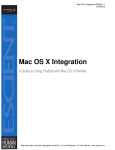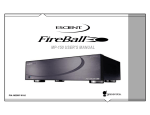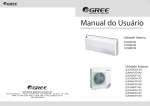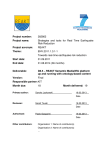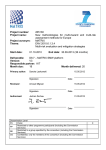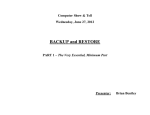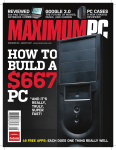Download Escient Fireball E-2 System information
Transcript
PC Integration WD044-1-2 3/23/2010 PC Integration A Guide to Using FireBall with Windows XP 6640 Intech Blvd. Suite 250 Indianapolis, IN 46278 317.616.6789 phone 317.616.6790 fax www.escient.com PC Integration WD044-1-1 3/23/2010 Table of Contents FireBall to PC Networking Basics .......................................................................................... 3 Overview ................................................................................................................................ 3 Requirements......................................................................................................................... 3 Connecting to Your FireBall ................................................................................................... 4 Setting up the FireBall Server ................................................................................................ 4 Accessing the CONTENT Volume from your PC ................................................................... 5 Backing Up Your FireBall........................................................................................................ 6 One Time Backup .................................................................................................................. 6 Automated Backups ............................................................................................................... 8 Installation and Configuration of the SyncBack Backup Software ...................................... 8 Integrating with iTunes and iPod ......................................................................................... 14 What You Can Do............................................................................................................. 14 What You Can’t Do........................................................................................................... 14 Importing Music Into iTunes ................................................................................................. 14 Creating iTunes Playlists...................................................................................................... 19 Burn CDs from iTunes.......................................................................................................... 20 Sync Playlists and Music to your iPod.................................................................................. 20 Music Taggging and the PC.................................................................................................. 21 What is a Tag?..................................................................................................................... 21 FireBall’s Tag Requirements................................................................................................ 21 Cover Art.............................................................................................................................. 21 Tag Editors........................................................................................................................... 21 Importing Music Into FireBall ............................................................................................... 24 Compatible Music File Formats............................................................................................ 24 Windows Vista/7 Fix............................................................................................................. 24 Apple FairPlay DRM & iTunes Plus...................................................................................... 24 Accessing the IMPORT Volume from your PC..................................................................... 25 Importing your Music Files ................................................................................................... 26 Controlling FireBall through your Web Browser ................................................................ 28 Requirements....................................................................................................................... 29 Connecting to Your FireBall ................................................................................................. 29 Controlling Your FireBall ...................................................................................................... 30 Using Custom Backgrounds ................................................................................................ 30 Background Image Requirements........................................................................................ 30 Accessing the Backgrounds Volume.................................................................................... 30 Assigning Imported Background Images.............................................................................. 31 Using the Photo Screen Saver ............................................................................................. 32 Photo Image Requirements ................................................................................................. 32 Accessing the Photos Volume ............................................................................................. 32 Enabling the Photo Screensaver.......................................................................................... 33 6640 Intech Blvd. Suite 250 Indianapolis, IN 46278 317.616.6789 phone 317.616.6790 fax www.escient.com PC Integration WD044-1-1 3/23/2010 FireBall to PC Networking Basics Overview With the Network File Sharing feature built into FireBall, you can access your FireBall from your PC using your home network. Having access to your FireBall allows you to do things like backup your music files, import music files from your PC to your FireBall, remotely control your FireBall from your PC, and share your FireBall based music with iTunes and the Apple iPod. This document will explain how to do all of these things using your PC and your FireBall over your home network. Requirements In order to connect to your FireBall, you will need to have your FireBall and PC on the same network. This document assumes that you already have a home network correctly setup and configured. If you need help setting up your network, please review the “Home Network Primer” available on the Escient web site, or contact your Escient dealer. The following items are required for connecting your PC to your FireBall: • Properly configured Ethernet home network • Fireball E2, DVDM- 300/552, SE-80, MX, AVX model Media Manager or FireBall E with E2 software update (http://www.escient.com/eupdate/) • PC computer with 64MB of RAM and Windows 2000/XP/Vista Installed • iTunes 4.5 or later 6640 Intech Blvd. Suite 250 Indianapolis, IN 46278 317.616.6789 phone 317.616.6790 fax www.escient.com PC Integration WD044-1-1 3/23/2010 Connecting to Your FireBall FireBall uses a type of file server commonly called “Windows Networking” or “CIFS/SMB”. CIFS/SMB networking found in most Microsoft operating systems and allows PCs to connect and share files over a network. Setting up the FireBall Server Before you can connect to your FireBall you must configure FireBall’s server settings. Follow these steps to configure your FireBall server: 1. Using your FireBall remote, press SETUP to display the Setup Menu. 2. Select the NETWORK menu item. 3. Select the SERVER SETTINGS menu item to display the Server Settings screen. 4. Enter a name for your FireBall using the remote or keyboard. Note: Do not use spaces or characters other than alpha-numeric (A-Z, 0-9) within the Fireball name. Maximum of 15 characters. 5. Select the SAVE button to save your settings. 6. Press SETUP again to exit the Setup menus. Server Settings screen 6640 Intech Blvd. Suite 250 Indianapolis, IN 46278 317.616.6789 phone 317.616.6790 fax www.escient.com PC Integration WD044-1-1 3/23/2010 Accessing the CONTENT Volume from your PC To access your FireBall’s CONTENT volume which contains all of your music files, click Start>Run, type \\ and the Fireball’s IP address or server name, and click OK. You may use the Fireball’s IP address and server name interchangeably in most cases. Example: suppose you named your FireBall “MyFireBall” in the Server Settings screen, you would then enter \\MyFireBall in the Run prompt, and click OK. Again, you may also use the Fireball’s IP address. If the Fireball’s IP address is 192.168.1.101, you would enter \\192.168.1.101 and click OK. Each of the Fireball’s individual network shares/volumes will then be displayed. Simply rightclick on the “Content” volume and select Create Shortcut. Click “Yes” to place a shortcut to the Fireball’s Content volume on your desktop. 6640 Intech Blvd. Suite 250 Indianapolis, IN 46278 317.616.6789 phone 317.616.6790 fax www.escient.com PC Integration WD044-1-1 3/23/2010 Backing Up Your FireBall Once you have successfully created a shortcut to the FireBall’s Content volume on your desktop, you now have access to the music content contained within the FireBall’s internal hard drive. Having access to this affords you the opportunity to backup your FireBall’s music collection. There are many ways to backup the music files including copying files to another drive mounted on your PC or using third party backup software to perform automated backups on a scheduled basis. Note: Internet Radio Stations and System Settings are not backed up. Only the actual music files stored on the Fireball internet hard drive are available for backup. One Time Backup If you are only going to make a one time backup of the FireBall for safe keeping, it is recommended to do a simple drag and drop of the Content volume to another hard drive or volume mounted on your PC. This one time backup method is useful if your FireBall music collection is not going to change much from day to day and you simply want to preserve a copy as a failsafe to some catastrophic event such as theft, loss by fire, or hard drive crash. This is typically done by an installer or dealer who wants to keep an offsite copy of the installed FireBall for safety reasons. Follow these steps to backup all music files from your FireBall to storage device accessible by your PC. 1. Double-click on the Content shortcut we created on your desktop earlier. (see “Accessing the CONTENT Volume from your PC”) 2. Select Edit>Select All to select all of the files and folders in the CONTENT volume. 3. While all the items on the Content volume are highlighted, either drag-and-drop or copyand-paste them to a storage location accessible by your PC. 6640 Intech Blvd. Suite 250 Indianapolis, IN 46278 317.616.6789 phone 317.616.6790 fax www.escient.com PC Integration WD044-1-1 3/23/2010 4. Go to your Backup drive and select Edit>Paste. 5. All of the items in the current selection will now be copied to the backup drive. Depending on the size of your music collection, this may take a while to complete. The FireBall will transfer about 5GB of data per hour (120GB a day). At this rate, it will take approximately 2 and a half days to backup an entire 300 GB drive over an Ethernet connection. 6640 Intech Blvd. Suite 250 Indianapolis, IN 46278 317.616.6789 phone 317.616.6790 fax www.escient.com PC Integration WD044-1-1 3/23/2010 Automated Backups If you are going to add new music or edit the contents of your FireBall frequently, it is recommended to setup an automated backup system. Based on an assigned schedule the contents of your FireBall that have been added, deleted, or edited will be copied to the backup folder on your computer. The backup software manages which files have changed compared to what is in the backup folder and copies only those files which have changed, keeping the FireBall’s CONTENT volume in sync with a duplicate volume. Installation and Configuration of the SyncBack Backup Software SyncBack is a software application designed to perform automated data backups and synchronization between storage devices and/or directories under Windows 2000/XP/Vista. The following instructions will allow you to configure SyncBack to perform an automated and incremental backup of your Fireball’s music library. Downloading SyncBack: Begin by downloading and installing SyncBack through the following URL: http://www.2brightsparks.com/downloads.html#freeware New Profile: Once installed and upon initial launch of SyncBack you will be prompted to create a new profile; select “Yes”: Profile Type: Since we plan to backup from a source location (Fireball) to a destination location on the PC (i.e. external hard drive) then we will need to select “Backup” as the profile type: Profile Name: Assign an appropriate name for the Fireball backup profile. Note: SyncBack supports multiple backup profiles if required: 6640 Intech Blvd. Suite 250 Indianapolis, IN 46278 317.616.6789 phone 317.616.6790 fax www.escient.com PC Integration WD044-1-1 3/23/2010 Profile Setup: Configuring the backup profile consists of assigning a source (Fireball) containing the Fireball’s music library and a destination (i.e. external hard drive) where to backup the music library to. Source: The source location can either be address by the Fireball’s server name or IP address. Within the Escient user interface you can locate and assign the Fireball’s server name within Setup>Network>Server Settings. The IP address can be located within Setup>Network>Ethernet Settings. Note: When using the Fireball’s IP address it is advised that a static address be assigned. Destination: The destination location can consist of any PC accessible storage device such as a location on an external hard drive, internal hard drive, or NAS (network attached storage) device. Note: Verify that “Backup the source directories files, including all its sub-directories” is selected. 6640 Intech Blvd. Suite 250 Indianapolis, IN 46278 317.616.6789 phone 317.616.6790 fax www.escient.com PC Integration WD044-1-1 3/23/2010 Simulated Run Confirmation: Once the backup profile has been created you will be prompted to perform a simulated run. This is not required at this time; select “No”: Skip Differences Window: Check “Skip Differences Window” within the preferences menu otherwise you will be prompted for confirmation before each backup. Automating the Backup: You may now choose to schedule the backup process to be performed on a set schedule. If so, right click on the newly created backup profile and select “Schedule”: Confirm New Schedule: Since a schedule does not already exist for the newly created profile you will be prompted to create one; select “Yes”: 6640 Intech Blvd. Suite 250 Indianapolis, IN 46278 317.616.6789 phone 317.616.6790 fax www.escient.com PC Integration WD044-1-1 3/23/2010 Windows XP - Blank/Empty Password Restriction: You may be prompted to remove the following restriction; select “No”: Set Password: Click “Set password” and enter the password that corresponds to your windows login to allow the backup process to run when the PC is on but a user is not currently logged in: Defining Backup Schedule: The backup process can be schedule to run on a daily, weekly, and/or monthly basis. For most users, either a weekly or monthly backup should suffice depending on how often additional music titles are added. Below is an ideal backup schedule. Note: It is best to perform the backup at a time when the PC is not in use in order to avoid any interruption in the user’s normal usage: 6640 Intech Blvd. Suite 250 Indianapolis, IN 46278 317.616.6789 phone 317.616.6790 fax www.escient.com PC Integration WD044-1-1 3/23/2010 Schedule Settings: By default “Stop the task if run for…” is selected within SETTINGS tab when defining the backup schedule. It is advised that this be unchecked in order to avoid any interruption in the backup process. Schedule Confirmation: Once an appropriate schedule has been defined click “OK” to apply the schedule. You will be prompted with a confirmation which outlines the assigned schedule. If everything looks correct; select “OK”. Otherwise you may make any desired changes by selecting “Edit Schedule” Performing Initial Backup: It is advised that you perform an initial backup to ensure that the backup profile has been properly created. Simply right click on the newly created backup profile and select “Run”. All future backups will be performed based on the schedule you have assigned: 6640 Intech Blvd. Suite 250 Indianapolis, IN 46278 317.616.6789 phone 317.616.6790 fax www.escient.com PC Integration WD044-1-1 3/23/2010 6640 Intech Blvd. Suite 250 Indianapolis, IN 46278 317.616.6789 phone 317.616.6790 fax www.escient.com PC Integration WD044-1-1 3/23/2010 Integrating with iTunes and iPod FireBall supports iTunes and iPod integration through the FireBall Network File Sharing feature described above. Once your PC is connected to your FireBall over the network, you can access FireBall’s music and use it from iTunes and sync it with your iPod. Please read the section Connecting to your FireBall before proceeding to make sure that you can access the FireBall’s CONTENT volume from your PC. What You Can Do Once you have access to FireBall’s Content share from your PC, you can: • Import FireBall MP3 music into iTunes • Create iTunes Playlists • Burn CDs using iTunes • Sync Playlists and Music to your Apple iPod (Note: Playlist must be created within iTunes. Fireball playlists will not be accessible within iTunes) What You Can’t Do Here are some things you can’t do with iTunes: • Copy Music from an iPod to FireBall • Copy iTunes Playlists to your FireBall • Access Fireball FLAC music tracks Importing Music Into iTunes iTunes allows music files to reside on different volumes or hard drives, including network volumes. Since FireBall’s CONTENT volume is really just another network volume to the PC OS, you can add your FireBall music to iTunes. iTunes creates and maintains it’s own Library index files which are separate from the actual music files that appear in it’s browser window. This means that the iTunes Music Library file can remain on your hard drive (usually located in your Music folder) while the actual music files are located on some other volume, like the FireBall CONTENT volume. Note: Since iTunes does not currently support FLAC files, only MP3 files from FireBall can be accessed within iTunes. 6640 Intech Blvd. Suite 250 Indianapolis, IN 46278 317.616.6789 phone 317.616.6790 fax www.escient.com PC Integration WD044-1-1 3/23/2010 Follow these steps to import your FireBall music content into iTunes: 1. After creating a link to the Fireball’s CONTENT volume on your desktop, open iTunes on your PC. 2. Select Preferences… from the iTunes menu 3. Click the Advanced icon in the toolbar to display the Advanced Preferences panel. 4. Make sure that Copy files to iTunes Music folder when adding to library is NOT checked. If it is checked, all music files imported into iTunes will be copied into your hard drive as they are imported. We don’t want to do this, because we simply want to access the music from FireBall, not duplicate it on the PC. 6640 Intech Blvd. Suite 250 Indianapolis, IN 46278 317.616.6789 phone 317.616.6790 fax www.escient.com PC Integration WD044-1-1 3/23/2010 5. Now double-click on the Content shortcut we created on your desktop earlier. You may choose to select/highlight your entire Fireball music library (Edit>Select All) or just select individual artists, albums, or tracks to be accessed within iTunes. Drag and drop the selected music files/folders from the Fireball’s CONTENT folder to the iTunes browser window. 6640 Intech Blvd. Suite 250 Indianapolis, IN 46278 317.616.6789 phone 317.616.6790 fax www.escient.com PC Integration WD044-1-1 3/23/2010 6. Wait while iTunes scans the selected music tracks and adds them to the iTunes Library. Note: This may take an extended period of time to complete depending on the size of the music library. 6640 Intech Blvd. Suite 250 Indianapolis, IN 46278 317.616.6789 phone 317.616.6790 fax www.escient.com PC Integration WD044-1-1 3/23/2010 6640 Intech Blvd. Suite 250 Indianapolis, IN 46278 317.616.6789 phone 317.616.6790 fax www.escient.com PC Integration WD044-1-1 3/23/2010 7. When all your music tracks have been imported, the iTunes browser window will display the music content from your FireBall, including cover art! You can now access your FireBall music from iTunes just as if it were located on your PC. Creating iTunes Playlists Now that your FireBall music has been added to the iTunes Library, you can create iTunes Playlists. Playlists can contain any combination of music available in the iTunes browser, no matter where it actually resides. Please refer to the iTunes Help screens for more detailed information about creating Playlists within iTunes. Note: iTunes actually streams each MP3 from FireBall in real-time over your network. This may limit the number of simultaneous client streams that your FireBall server can play at once. 6640 Intech Blvd. Suite 250 Indianapolis, IN 46278 317.616.6789 phone 317.616.6790 fax www.escient.com PC Integration WD044-1-1 3/23/2010 Burn CDs from iTunes Again, since your FireBall music has been added to the iTunes Library, you can burn CDs directly from iTunes Playlists on your PC. Playlists can contain any combination of music available in the iTunes browser, no matter where it actually resides. In iTunes, you burn a CD from a Playlist. Create a Playlist in iTunes with the songs you want on your CD, then click the Burn icon in the upper right corner of the screen. Please refer to the iTunes Help screens for more detailed information about creating Playlists within iTunes. Sync Playlists and Music to your iPod Once again, since your FireBall music has been added to the iTunes Library, you can also sync iTunes Playlists to your iPod. Your iPod can contain any combination of music available in the iTunes browser, no matter where it actually resides. Please refer to the iTunes Help screens for more detailed information about syncing music to an iPod using iTunes. Note: Remember that iTunes does not support FLAC files, so only FireBall MP3 files can be synced to an iPod. 6640 Intech Blvd. Suite 250 Indianapolis, IN 46278 317.616.6789 phone 317.616.6790 fax www.escient.com PC Integration WD044-1-1 3/23/2010 Music Tagging and the PC What is a Tag? Most digitally encoded file formats allow information particular to each file to be embedded within the file itself. This information is referred to as metadata and is included within what is known as a tag. A tag can include a multitude of information of which can contain but is not limited to artist, album, track, year, genre, and cover art. FireBall’s Tag Requirements In order for the Fireball to properly display all artist/album/track/cover art metadata once the music file(s) have been imported, the file must first contain a proper tag embedded within the music file itself. Different types of tags are used depending on the file format being imported. The following list describes the corresponding tag which each music format requires. • • • • MP3 (ID3 Version 1.0, 1.1, 2.2, and 2.3) FLAC (Ogg Vorbis) WMA (Microsoft Standardized) AAC (Apple Standardized) In order to for your music files to import properly all tracks must include an artist name, album name, track name, track #, and genre (group). Tracks which are to remain as a single album once imported need to have an identical artist name, album name, genre, along with a unique track # (i.e. 1, 2, 3, etc.) per track. Cover Art In order for Fireball to display cover art for your imported music files or when shared through the Fireball-PC application, the cover art must be embedded within the tag information of each track. All embedded cover art must be under 50KB in size and under 500x500 pixels in resolution in order to be recognize by FireBall. Tag Editors Mp3tag is our current recommended PC tag editor and handles each of the above mentioned file formats. You may even use Mp3tag to embed cover art within your music files. Mp3tag can be downloaded from the following location. http://www.mp3tag.de/en/. Apple iTunes is another common alternate PC tag editor. Follow these steps to convert your MP3 files to use ID3v2.3 tags BEFORE importing them to your FireBall. 1. Select the Library in the iTunes Source list. 2. Type Ctrl+A to select all of the Songs in your Library. 6640 Intech Blvd. Suite 250 Indianapolis, IN 46278 317.616.6789 phone 317.616.6790 fax www.escient.com PC Integration WD044-1-1 3/23/2010 3. Select Convert ID3 Tags… from the Advanced menu. 4. When the Convert ID3 Tags dialog is displayed, select v2.3 from the drop down menu, then select OK. 6640 Intech Blvd. Suite 250 Indianapolis, IN 46278 317.616.6789 phone 317.616.6790 fax www.escient.com PC Integration WD044-1-1 3/23/2010 5. The ID3 tags within all of the selected songs will be converted to v2.3 and thus compatible with the FireBall. Note: Because the CONTENT volume is a read-only volume, you cannot edit anything. You must first copy any files you want to edit onto your PC and then import them back into your FireBall, replacing the originals. Please see the section Importing Music Into FireBall for instructions on how to get your music files into your FireBall using the IMPORT volume. 6640 Intech Blvd. Suite 250 Indianapolis, IN 46278 317.616.6789 phone 317.616.6790 fax www.escient.com PC Integration WD044-1-1 3/23/2010 Importing Music Into FireBall FireBall’s CONTENT volume is read-only, which means you can’t write to it or use it for importing music files from your PC to your FireBall. There is a way! FireBall actually provides two server volumes, one for reading your music collection and one for importing your music collection. The difference is that the IMPORT volume is a writeable volume while the CONTENT volume is read only. Compatible Music File Formats Fireball E, E2, DVDM-300/552, SE-80, MX, AVX model Media Managers and & Fireball-PC supported file formats: - MP3 (Up to 320Kbps CBR. VBR is supported) - FLAC* - WMA (192Kbps CBR / 215Kbps VBR. Lossless is not supported) - AAC** (Lossless is not supported) * SE-80 does not support FLAC. ** Requires Fireball software version 4.2 or later. Fireball-PC requires version 4.2.3.6 or later (v4.2 update subscribe http://www.escient.com/support/updates.html) *** Fireball E models (E-40/120) require the following E2 software update in order to import music files from your PC/Mac. http://www.escient.com/eupdate/ Windows Vista/7 Fix Both Windows Vista and Windows 7 may potentially corrupt music files during transfer to an Escient Fireball. This results in skipping audio throughout playback on the Fireball. Again, this only pertains to Windows Vista/7. Using Windows XP, Mac OS X, Linux, etc. and you will not encounter this corruption when transferring to the Fireball. Therefore, the current work-around is to download and install an application called TeraCopy which is a replacement to the default Windows explorer file transfer utility and will not corrupt the music files. Then perform the transfer just the same as you did previously. Download TeraCopy http://www.codesector.com/teracopy.php Apple FairPlay DRM & iTunes Plus DRM, which stands for Digital Rights Management, is a technology used mainly in restricting the playback of most legally purchased music through online music stores. DRM was created on behalf of the music industry as a whole to allow content owners to determine and control who and how users can view content such as media files on the Internet. However, there are both advantages and disadvantages to DRM. Unfortunately, due to DRM, compatibility between music playback hardware and software is severely limited. Any company wishing to produce hardware/software compatible with music files that include DRM technology must directly support each type of DRM technology and it is up to the company in which the music files are distributed on whether to license this technology out to 3rd party companies. Music files purchased through the iTunes online music service must be purchased in an unprotected format in order to transfer the files to the FireBall. Apple calls their DRM-free 6640 Intech Blvd. Suite 250 Indianapolis, IN 46278 317.616.6789 phone 317.616.6790 fax www.escient.com PC Integration WD044-1-1 3/23/2010 (unprotected) content “iTunes Plus”. If you’ve previously purchased content in a protected format, Apple will allow you re-purchase this content in iTunes Plus format for a few additional cents per track. Each track’s file extension will end in .m4a if it’s in a compatible, unprotected AAC format. However, if the track ends in a .m4p extension (protected) or is in AAC lossless format then it is not compatible. Accessing the IMPORT Volume from your PC Accessing your FireBall’s IMPORT volume is done in an almost-identical fashion as accessing the CONTENT volume. To do so, begin by clicking Start>Run, type \\ and the Fireball’s IP address or server name, and click OK. You may use the Fireball’s IP address and server name interchangeably in most cases. Example: suppose you named your FireBall “MyFireBall” in the Server Settings screen, you would then enter \\MyFireBall in the Run prompt, and click OK. Again, you may also use the Fireball’s IP address. If the Fireball’s IP address is 192.168.1.101, you would enter \\192.168.1.101 and click OK. Each of the Fireball’s individual network shares/volumes will then be displayed. Simply rightclick on the IMPORT volume and select Create Shortcut. Click “Yes” to place a shortcut to the Fireball’s IMPORT volume on your desktop. 6640 Intech Blvd. Suite 250 Indianapolis, IN 46278 317.616.6789 phone 317.616.6790 fax www.escient.com PC Integration WD044-1-1 3/23/2010 Importing your Music Files Once you have access to the IMPORT volume, simply double-click on the IMPORT shortcut and drag-and-drop any Fireball-compatible music files into the empty IMPORT window. The files will be copied to FireBall and added to the FireBall Music Library. You can drag and drop whole collections, a folder of songs, or just a single song. When the music files are copied to the FireBall, you will see the new songs appear on your FireBall’s Music Guide, under the” artist – album name” as defined in the file’s embedded tag. 6640 Intech Blvd. Suite 250 Indianapolis, IN 46278 317.616.6789 phone 317.616.6790 fax www.escient.com PC Integration WD044-1-1 3/23/2010 6640 Intech Blvd. Suite 250 Indianapolis, IN 46278 317.616.6789 phone 317.616.6790 fax www.escient.com PC Integration WD044-1-1 3/23/2010 Note: The IMPORT directory may contain special “cache files” in it if you have previously imported music into your FireBall. These files are just temporary cache files that appear to be the original music files, however they are not. They are just temporary “stub” files that indicate what you previously imported into your FireBall. You can delete these files without actually deleting the originals which physically reside on the CONTENT volume. The IMPORT volume displaying the temporary cache files. Note the 0 KB file size. 6640 Intech Blvd. Suite 250 Indianapolis, IN 46278 317.616.6789 phone 317.616.6790 fax www.escient.com PC Integration WD044-1-1 3/23/2010 Controlling FireBall through your Web Browser FireBall contains a built-in web server capable of serving web pages specifically designed to control almost every aspect of the FireBall from a standard web browser. Requirements In order to control your FireBall from a web browser, you will need to meet the following requirements: • Your PC and FireBall must be on the same Ethernet network • Windows 2000/XP/Vista/7 • Internet Explorer 6 or later (or alternate browser) Connecting to Your FireBall Before you can connect to your FireBall from your PC’s web browser, you must obtain the “IP Address” of your FireBall. Follow these steps to determine the IP Address: 1. 2. 3. 4. Press the SETUP key on the remote to display the Setup menu. Select the Utilities menu item. Select the System Information menu item. Write down the IP Address of your FireBall’s Ethernet connection. This number is located in the bottom right of the System Information screen and consists of four numbers separated by periods. Example: 192.168.1.101 5. Press the SETUP key again to exit Setup From your PC, open Internet Explorer or alternate browser, enter the IP address of your FireBall into the Address Bar and press <Enter>. You should now see the familiar FireBall user interface on your PC. Note: You may also enter the Fireball’s server name within the address bar of your browser to access the Fireball’s web interface. 6640 Intech Blvd. Suite 250 Indianapolis, IN 46278 317.616.6789 phone 317.616.6790 fax www.escient.com PC Integration WD044-1-1 3/23/2010 Controlling Your FireBall The FireBall Web Client Interface is the graphics and control system web pages that appear in within your web browser. From this web page, you can control almost every aspect of your FireBall, just as you would from the original IR remote and TV. You will notice that unlike the TV user interface, there are buttons along the left and right edges of the web browser. These buttons duplicate the features found on your remote control. 6640 Intech Blvd. Suite 250 Indianapolis, IN 46278 317.616.6789 phone 317.616.6790 fax www.escient.com PC Integration WD044-1-1 3/23/2010 Using Custom Backgrounds In addition to the Escient Classic user interface theme, the FireBall allows you to select preloaded custom themes or even select your own background images for each Guide, Player, Options, Setup, and Message screens. You can import your own background images into the Backgrounds shared directory using the Fireball’s file sharing interface. Background Image Requirements The image requirements are the same for 4x3 or 16x9 backgrounds. Background images are scaled horizontally when the FireBall video format is set to 16x9. FireBall automatically reserves .02% (multiply total hard drive capacity by .0002) of the total hard drive capacity for the Backgrounds volume. • 720x480 72dpi • Each image must be under 500K bytes in size • jpg, gif, or png formats are supported Accessing the Backgrounds Volume To access your FireBall’s BACKGROUNDS volume, which is used to store all custom background images, click Start>Run, type \\ and the Fireball’s IP address or server name, and click OK. You may use the Fireball’s IP address and server name interchangeably in most cases. Example: suppose you named your FireBall “MyFireBall” in the Server Settings screen, you would then enter \\MyFireBall in the Run prompt, and click OK. Again, you may also use the Fireball’s IP address. If the Fireball’s IP address is 192.168.1.101, you would enter \\192.168.1.101 and click OK. Each of the Fireball’s individual network shares/volumes will then be displayed. Simply rightclick on the “Backgrounds” volume and select Create Shortcut. 6640 Intech Blvd. Suite 250 Indianapolis, IN 46278 317.616.6789 phone 317.616.6790 fax www.escient.com PC Integration WD044-1-1 3/23/2010 Click “Yes” to place a shortcut to the Fireball’s Backgrounds volume on your desktop. Double-click on the Background shortcut we placed on your desktop and drag-and-drop or copy-and-paste your images into the Backgrounds volume. Assigning Imported Background Images After importing your custom background images, using the handheld remote press SETUP, select GENERAL, and select USER INTERFACE SKINS. Select and place a check mark next to CUSTOM and SAVE. You will then be prompted to assign a background image to each individual user interface screen (i.e. music guide, music player, radio guide, radio player, etc.) 6640 Intech Blvd. Suite 250 Indianapolis, IN 46278 317.616.6789 phone 317.616.6790 fax www.escient.com PC Integration WD044-1-1 3/23/2010 Using the Photo Screen Saver FireBall Media Manager products with built-in hard drives provide a Photo Screen Saver feature, which allows custom photos or images to be displayed whenever the screen saver is activated. Photo Image Requirements Photos are authoatically scaled horizontally and vertically depending on the current video format (4x3 or 16x9) to reach the top/bottom or sides of the screen. FireBall automatically reserves .02% (multiply total hard drive size by .0002) of the total hard drive capacity for the Photos volume. • Photos can be any size however, o 720x480 72dpi to fill the entire screen when the video format is set to 4x3 o 640x360 72dpi to fill the entire screen when the video format is set to 16x9 • Each image must be under 500K bytes in size • jpg, gif, or png formats are supported Accessing the Photos Volume To access your FireBall’s PHOTOS volume, which is used to store all custom screen saver photos, click Start>Run, type \\ and the Fireball’s IP address or server name, and click OK. You may use the Fireball’s IP address and server name interchangeably in most cases. Example: suppose you named your FireBall “MyFireBall” in the Server Settings screen, you would then enter \\MyFireBall in the Run prompt, and click OK. Again, you may also use the Fireball’s IP address. If the Fireball’s IP address is 192.168.1.101, you would enter \\192.168.1.101 and click OK. Each of the Fireball’s individual network shares/volumes will then be displayed. Simply rightclick on the “Photos” volume and select Create Shortcut. 6640 Intech Blvd. Suite 250 Indianapolis, IN 46278 317.616.6789 phone 317.616.6790 fax www.escient.com PC Integration WD044-1-1 3/23/2010 Click “Yes” to place a shortcut to the Fireball’s Photos volume on your desktop. Enabling the Photo Screensaver In order to enable the photo screensaver to display your imported photos/images press SETUP on the handheld remote, select GENERAL, and select SCREENSAVER. Select PHOTOS as the desired type of screen saver. You may also choose the desired time of inactivity before the screensaver is displayed and whether to display your imported photos in either alphabetical (based on file name) or random order. 6640 Intech Blvd. Suite 250 Indianapolis, IN 46278 317.616.6789 phone 317.616.6790 fax www.escient.com


































